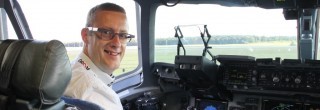 Just like many of you I have been following many astronauts during training, mission, return and whatever happens after return. For us spacetweeps it is great to see what it means to be an astronaut. What happens during training, how they prepare for their work in space and the launch, how they experience their time in space and how they communicate with those of us that stay behind on the planet? Obviously social media is the perfect way to keep this communication channel open throughout this entire process. We love to follow our astro_’s on Twitter!
Just like many of you I have been following many astronauts during training, mission, return and whatever happens after return. For us spacetweeps it is great to see what it means to be an astronaut. What happens during training, how they prepare for their work in space and the launch, how they experience their time in space and how they communicate with those of us that stay behind on the planet? Obviously social media is the perfect way to keep this communication channel open throughout this entire process. We love to follow our astro_’s on Twitter!
Ever since @Astro_TJ sent the first live tweet from space we have witnessed an effect that I will coin “The ISS Effect” in social media. As soon as an astronaut starts tweeting from space, the number of followers skyrockets (pun intended). This effect does not happen before a mission and certainly not after, but immediately after launch. I am sure that the agencies know this effect very well. It must be the jewel in the crown for every space agency social media manager. And this is good news. It means that the general public is interested in what happens in space! Especially pictures of our home town and country from the station are extremely popular, as are everyday live scenes on board the station: playing instruments, eating and drinking together, doing weird weightlessness tricks… Anything not too scientific will do.
And the astronauts are getting better and better at this, probably after some informal social media ‘training’ and help from the ground. Current champion is the latest tweep-in-space @Cmdr_Hadfield, who has attracted a massive 585,000 followers on Twitter. I am sure that his employers at @CSA_ASC are more than thrilled with all this free (?) publicity!
In order to prove that the effect is real, I would like to conduct a space science experiment here in the Spacetweep Society blog. It is very simple. I will publish a short table of past, current and future tweeps in space and their popularity on Twitter, expressed as their follower count. We will then put this blog away for 6 to 24 months (space experiments have a long lead time) and see what has happened. Please follow along with me!
- Past: TJ Creamer (NASA) @Astro_TJ – 42,033 followers (last in space 2010)
- Past: Paolo Nespoli (ESA) @Astro_Paolo – 82,749 followers (last in space 2011)
- Past: Ron Garan (NASA) @Astro_Ron – 95,057 followers (last in space 2011)
- Past: Andre Kuipers (ESA) @Astro_Andre – 274,674 followers (last in space 2012)
- Present: Thomas Marshburn (NASA) @AstroMarshnurn – 29,891 followers
- Present: Chris Hadfield (CSA) @Cmdr_Hadfield – 585,647 followers
- Future: Karen Nyberg (NASA) @AstroKarenN – 2,013 followers (launch May 2013)
- Future: Terry Virts (NASA) @Astro_Terry – 2,288 followers (launch Dec 2014)
- Future: Alexander Gerst (ESA) @Astro_Alex – 3,278 followers (launch May 2014)
- Future: Reid Wiseman (NASA) @Astro_Reid – 4,056 followers (launch May 2014)
- Future: Luca Parmitano (ESA) @Astro_Luca – 8,983 followers (launch May 2013)
- Future: Sam Cristoforetti (ESA) @AstroSamantha – 21,260 followers (launch Dec 2014)
Now obviously there are other effects here too, like activity (measured by frequency of tweets), history (number of tweets and date of first tweet), gender (women astro’s are more popular than men) and post-astro career path (@Astro_Mike went into showbizz and now has 1,260,476 followers, while other astro’s stop tweeting altogether after their return). Anyway, let’s see what this little list will look like next year and in 2015.
Crosspost from the Spacetweep Society blog, published 28-Mar-2013
